Do you have a question about the Panasonic TH-55EQ1U and is the answer not in the manual?
Key instructions to ensure safe operation and adherence to warnings.
Guidelines for safe placement, ventilation, usage of accessories, and maintenance.
Recommendations for installing the display using specified accessories and correct number of people.
Detailed instructions and warnings for secure wall mounting and pedestal installation.
Guidelines for safe handling, cleaning, and usage of the power cord and plug.
Warnings against inserting objects, removing covers, and general electrical safety.
Guidelines on suitable locations, temperature limits, and ventilation requirements for optimal performance.
Steps for connecting and securing the AC power cord to the display unit.
Identification and location of the power indicator and remote control sensor on the display.
Overview of external terminals and buttons on the main unit for operation.
Explanation of each button's function on the remote control transmitter.
Steps for connecting the AC power cord and turning the unit on using the main power button.
Guide on how to switch between different input sources connected to the display.
Guide to controlling the picture's aspect ratio for optimal display.
Instructions on how to zoom into specific screen areas and adjust zoom ratios.
Steps for accessing and navigating the on-screen menu to adjust settings.
Steps for manually adjusting the picture's horizontal and vertical position and size.
Guide to using the Auto Setup feature for optimal PC signal display.
How to select audio output and choose sound modes like Normal, Dynamic, or Clear.
Guide to selecting picture modes and adjusting backlight, contrast, brightness, colour, and hue.
Instructions for adjusting gamma, colour temperature, and storing custom user settings.
How to adjust colour tone, saturation, brightness, and dynamic contrast.
Procedures for saving, loading, and editing picture adjustment profiles for convenience.
Step-by-step guide to saving current picture settings as named profiles.
Instructions for applying previously saved picture profiles to the display.
Procedures for removing unwanted profiles or changing their names.
Steps to open and navigate the main Setup menu.
How to configure signal inputs and select appropriate formats for HDMI, DVI-D, and PC.
Options for selecting YUV/RGB input and enabling cinema reality for video playback.
Settings to reduce picture noise and block noise in MPEG videos.
Configuring XGA signals and adjusting signal range for optimal PC input.
Adjusting input levels, 3D Y/C filter, and colour system for AV IN input.
Settings to improve motion quality and adjust backlight for contrast.
Customizing power-on behavior, including initial input and volume levels.
Configuring power-saving features and notification messages for power status.
Setting up automatic input switching based on signal presence or custom search.
Configuring the failover/failback feature for automatic switching to a backup input.
Setting up quick input changes and defining primary/secondary backup inputs.
Configuring normal input switching and auto return to the main input.
Setting screensaver activation, intervals, and display patterns to prevent image retention.
Setting timed activation of screensaver and automatic power off after screensaver.
Configuring automatic power off when no signal is detected and managing power for specific inputs.
Enabling and configuring HDMI-CEC for device interlocking and remote control.
Setting up interlocking control between the display and connected HDMI-CEC devices.
Customizing the image displayed on power-on or when no signal is present.
Procedures for setting default or user-defined startup and no-signal images.
Selecting OSD language and configuring multi-display layouts for synchronized viewing.
Creating timer programs for automatic power on/off with specific inputs.
Setting custom days for timer programs and configuring the unit's date and time.
Enabling network control and managing the display's name on the network.
Configuring network settings including IP address, subnet mask, gateway, and DHCP.
Activating the USB media player and schedule playback functions.
Requirements for using web browser control, including disabling proxy and enabling JavaScript.
Overview of the USB media player's capabilities and supported file types.
Details on supported file extensions, formats, and limitations for media playback.
Explanation of the Memory Viewer function and the types of files it supports.
Understanding and configuring interlocking operations between the display and HDMI-CEC devices.
Steps to copy display settings and data to a USB memory device.
Common issues related to picture and sound, with checks to perform before service.
Solutions for picture cutoff, unit heating, and issues with RS-232C or LAN connectivity.
Key instructions to ensure safe operation and adherence to warnings.
Guidelines for safe placement, ventilation, usage of accessories, and maintenance.
Recommendations for installing the display using specified accessories and correct number of people.
Detailed instructions and warnings for secure wall mounting and pedestal installation.
Guidelines for safe handling, cleaning, and usage of the power cord and plug.
Warnings against inserting objects, removing covers, and general electrical safety.
Guidelines on suitable locations, temperature limits, and ventilation requirements for optimal performance.
Steps for connecting and securing the AC power cord to the display unit.
Identification and location of the power indicator and remote control sensor on the display.
Overview of external terminals and buttons on the main unit for operation.
Explanation of each button's function on the remote control transmitter.
Steps for connecting the AC power cord and turning the unit on using the main power button.
Guide on how to switch between different input sources connected to the display.
Guide to controlling the picture's aspect ratio for optimal display.
Instructions on how to zoom into specific screen areas and adjust zoom ratios.
Steps for accessing and navigating the on-screen menu to adjust settings.
Steps for manually adjusting the picture's horizontal and vertical position and size.
Guide to using the Auto Setup feature for optimal PC signal display.
How to select audio output and choose sound modes like Normal, Dynamic, or Clear.
Guide to selecting picture modes and adjusting backlight, contrast, brightness, colour, and hue.
Instructions for adjusting gamma, colour temperature, and storing custom user settings.
How to adjust colour tone, saturation, brightness, and dynamic contrast.
Procedures for saving, loading, and editing picture adjustment profiles for convenience.
Step-by-step guide to saving current picture settings as named profiles.
Instructions for applying previously saved picture profiles to the display.
Procedures for removing unwanted profiles or changing their names.
Steps to open and navigate the main Setup menu.
How to configure signal inputs and select appropriate formats for HDMI, DVI-D, and PC.
Options for selecting YUV/RGB input and enabling cinema reality for video playback.
Settings to reduce picture noise and block noise in MPEG videos.
Configuring XGA signals and adjusting signal range for optimal PC input.
Adjusting input levels, 3D Y/C filter, and colour system for AV IN input.
Settings to improve motion quality and adjust backlight for contrast.
Customizing power-on behavior, including initial input and volume levels.
Configuring power-saving features and notification messages for power status.
Setting up automatic input switching based on signal presence or custom search.
Configuring the failover/failback feature for automatic switching to a backup input.
Setting up quick input changes and defining primary/secondary backup inputs.
Configuring normal input switching and auto return to the main input.
Setting screensaver activation, intervals, and display patterns to prevent image retention.
Setting timed activation of screensaver and automatic power off after screensaver.
Configuring automatic power off when no signal is detected and managing power for specific inputs.
Enabling and configuring HDMI-CEC for device interlocking and remote control.
Setting up interlocking control between the display and connected HDMI-CEC devices.
Customizing the image displayed on power-on or when no signal is present.
Procedures for setting default or user-defined startup and no-signal images.
Selecting OSD language and configuring multi-display layouts for synchronized viewing.
Creating timer programs for automatic power on/off with specific inputs.
Setting custom days for timer programs and configuring the unit's date and time.
Enabling network control and managing the display's name on the network.
Configuring network settings including IP address, subnet mask, gateway, and DHCP.
Activating the USB media player and schedule playback functions.
Requirements for using web browser control, including disabling proxy and enabling JavaScript.
Overview of the USB media player's capabilities and supported file types.
Details on supported file extensions, formats, and limitations for media playback.
Explanation of the Memory Viewer function and the types of files it supports.
Understanding and configuring interlocking operations between the display and HDMI-CEC devices.
Steps to copy display settings and data to a USB memory device.
Common issues related to picture and sound, with checks to perform before service.
Solutions for picture cutoff, unit heating, and issues with RS-232C or LAN connectivity.
| Screen Size | 55 inches |
|---|---|
| Panel Type | IPS |
| Brightness | 350 cd/m² |
| Contrast Ratio | 1200:1 |
| Viewing Angle | 178°/178° |
| VESA Mounting | 400 x 400 mm |
| Display Type | LCD |
| Aspect Ratio | 16:9 |
| Refresh Rate | 60 Hz |
| Resolution | 3840 x 2160 |
| Response Time | 8 ms |
| HDMI | 3 |
| DisplayPort | DisplayPort x 1 |
| USB | 2 |
| Output Terminals | Audio out |
| Built-in Speakers | Yes |
| Inputs | HDMI, DisplayPort, USB |
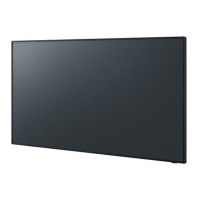
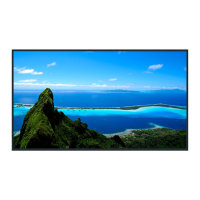
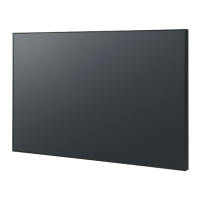
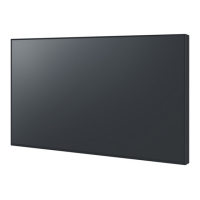
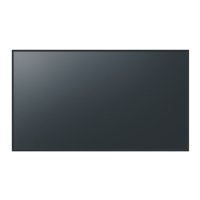




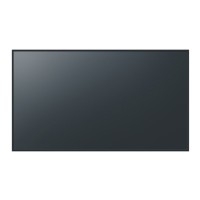


